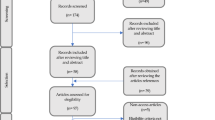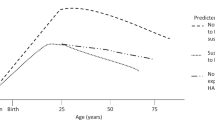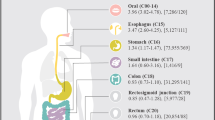Abstract
Arsenic and prior lung diseases have been shown to increase lung cancer risk; however, little is known about their joint effects. The aim of our study was to analyze the joint effects of inhaled arsenic and prior lung diseases on lung cancer risk within a occupational cohort. The interactions of prior lung diseases and inhaled arsenic were analyzed based on multiplicative and additive scales in the Cox proportional hazards model. Compared with low arsenic exposure and no history of asthma, the hazard ratios (HRs) of high arsenic exposure with asthma, high arsenic exposure without asthma and low arsenic exposure with asthma were 2.61 (95% CI: 1.71–4.00), 2.60 (95% CI: 1.93–3.51) and 2.49 (95% CI: 1.53–4.06), respectively. Based on the multiplicative scale in the Cox proportional hazards model, the HR of the interaction of asthma and arsenic on lung cancer risk was 0.45 (95% CI: 0.25–0.80). Based on the additive scale, the relative excess risk due to interaction between asthma and arsenic was −1.41 (95% CI: −2.81 to −0.02). Our study provides strong evidence that arsenic exposure is associated with lung cancer risk. A significant negative interaction between asthma and arsenic on lung cancer risk is observed.
This is a preview of subscription content, access via your institution
Access options
Subscribe to this journal
Receive 6 print issues and online access
$259.00 per year
only $43.17 per issue
Buy this article
- Purchase on Springer Link
- Instant access to full article PDF
Prices may be subject to local taxes which are calculated during checkout

Similar content being viewed by others
References
Zheng R, Zeng H, Zuo T, Zhang S, Qiao Y, Zhou Q et al. Lung cancer incidence and mortality in China, 2011. Thorac Cancer 2016; 7: 94–99.
Wang JB, Fan YG, Jiang Yong, Ping Li, Xiao HJ, Chen WQ et al. Attributable causes of lung cancer incidence and mortality in China. Thoracic Cancer 2011; 2: 156–163.
Krewski D, Lubin JH, Zielinski JM, Alavanja M, Catalan VS, Field RW et al. Residential radon and risk of lung cancer: a combined analysis of 7 North American case-control studies. Epidemiology 2005; 16: 137–145.
Steenland K, Loomis D, Shy C, Simonsen N . Review of occupational lung carcinogens. Am J Ind Med 1996; 29: 474–490.
Yokota J, Shiraishi K, Kohno T . Genetic basis for susceptibility to lung cancer: recent progress and future directions. Adv Cancer Res 2010; 109: 51–72.
Guo Y, Zeng H, Zheng R, Li S, Barnett AG, Zhang S et al. The association between lung cancer incidence and ambient air pollution in China: a spatiotemporal analysis. Environ Res 2016; 144: 60–65.
Brenner DR, McLaughlin JR, Hung RJ . Previous lung diseases and lung cancer risk: a systematic review and meta-analysis. PLoS One 2011; 6: e17479.
Biesalski HK, Bueno de Mesquita B, Chesson A, Chytil F, Grimble R, Hermus RJ et al. European Consensus Statement on Lung Cancer: risk factors and prevention. Lung Cancer Panel. CA Cancer J Clin 1998; 48: 167–176; discussion 164-166.
Fan YG, Jiang Y, Chang RS, Yao SX, Jin P, Wang W et al. Prior lung disease and lung cancer risk in an occupational-based cohort in Yunnan, China. Lung Cancer 2011; 72: 258–263.
Wang XR, Yu IT, Chiu YL, Qiu H, Fu Z, Goggins W et al. Previous pulmonary disease and family cancer history increase the risk of lung cancer among Hong Kong women. Cancer Causes Control 2009; 20: 757–763.
Turner MC, Chen Y, Krewski D, Calle EE, Thun MJ . Chronic obstructive pulmonary disease is associated with lung cancer mortality in a prospective study of never smokers. Am J Respir Crit Care Med 2007; 176: 285–290.
Bae JM, Li ZM, Shin MH, Kim DH, Lee MS, Ahn YO . Pulmonary tuberculosis and lung cancer risk in current smokers: the Seoul Male Cancer Cohort Study. J Korean Med Sci 2013; 28: 896–900.
Hosgoodiii HD, Chapman RS, He X, Hu W, Tian L, Liu LZ et al. History of lung disease and risk of lung cancer in a population with high household fuel combustion exposures in rural China. Lung Cancer 2013; 81: 343–346.
IARC Working Group on the Evaluation of Carcinogenic Risks to Humans. Arsenic and arsenic compounds. In: IARC Some Metals and Metallic Compounds, 23rd edn. IARC: Lyon, 1980.
Sekeres MA . New data with arsenic trioxide in leukemias and myelodysplastic syndromes. Clin Lymph Myeloma 2007; 8 (Suppl. 1): S7–S12.
Hertz-Picciotto I, Smith AH, Holtzman D, Lipsett M, Alexeeff G . Synergism between occupational arsenic exposure and smoking in the induction of lung cancer. Epidemiology 1992; 3: 23–31.
Fan YG, Hu P, Jiang Y, Chang RS, Yao SX, Wang W et al. Association between sputum atypia and lung cancer risk in an occupational cohort in Yunnan, China. Chest 2009; 135: 778–785.
Ratnasinghe D, Yao SX, Tangrea JA, Qiao YL, Andersen MR, Barrett MJ et al. Polymorphisms of the DNA repair gene XRCC1 and lung cancer risk. Cancer Epidemiol Biomarkers Prev 2001; 10: 119–123.
Taylor PR, Qiao YL, Schatzkin A, Yao SX, Lubin J, Mao BL et al. Relation of arsenic exposure to lung cancer among tin miners in Yunnan Province, China. Br J Ind Med 1989; 46: 881–886.
Qiao YL, Taylor PR, Yao SX, Erozan YS, Luo XC, Barrett MJ et al. Risk factors and early detection of lung cancer in a cohort of Chinese tin miners. Ann Epidemiol 1997; 7: 533–541.
Wu ZZ, Liu YT, Wei XY, Chen Z, Wang AD . Chemical etiology study among tin miners. J Hyg Res 1980; 9: 15–20.
J RK. Epidemiology: An Introduction. Oxford University Press: New York. 2002.
Li R, Chambless L . Test for additive interaction in proportional hazards models. Ann Epidemiol 2007; 17: 227–236.
Agency for Toxic Substances and Disease Registry (ATSDR) USPHS, U.S. Department of Health and Human Services. Toxicological Profile for Arsenic (Update). Atlanta, GA, 2007.
Santillan AA, Camargo CA, Jr, Colditz GA . A meta-analysis of asthma and risk of lung cancer (United States). Cancer Causes Control 2003; 14: 327–334.
Koshiol J, Rotunno M, Consonni D, Pesatori AC, De Matteis S, Goldstein AM et al. Chronic obstructive pulmonary disease and altered risk of lung cancer in a population-based case-control study. PLoS One 2009; 4: e7380.
Ballaz S, Mulshine JL . The potential contributions of chronic inflammation to lung carcinogenesis. Clin Lung Cancer 2003; 5: 46–62.
Azad N, Rojanasakul Y, Vallyathan V . Inflammation and lung cancer: roles of reactive oxygen/nitrogen species. J Toxicol Environ Health B Crit Rev 2008; 11: 1–15.
IARC. A Review of Human Carcinogens: Arsenic, Metals, Fibres, and Dusts. Lyon, 2012.
Enterline PE, Henderson VL, Marsh GM . Exposure to arsenic and respiratory cancer. A reanalysis. Am J Epidemiol 1987; 125: 929–938.
Lubin JH, Moore LE, Fraumeni JF, Jr, Cantor KP . Respiratory cancer and inhaled inorganic arsenic in copper smelters workers: a linear relationship with cumulative exposure that increases with concentration. Environ Health Perspect 2008; 116: 1661–1665.
Jarup L, Pershagen G . Arsenic exposure, smoking, and lung cancer in smelter workers—a case-control study. Am J Epidemiol 1991; 134: 545–551.
Cocco P, Rice CH, Chen JQ, McCawley M, McLaughlin JK, Dosemeci M . Non-malignant respiratory diseases and lung cancer among Chinese workers exposed to silica. J Occup Environ Med 2000; 42: 639–644.
Love RG, Muir DC . Aerosol deposition and airway obstruction. Am Rev Respir Dis 1976; 114: 891–897.
Laube BL, Swift DL, Wagner HN, Jr . Norman PS, Adams GK, 3rd . The effect of bronchial obstruction on central airway deposition of a saline aerosol in patients with asthma. Am Rev Respir Dis 1986; 133: 740–743.
Liu YT . In vivo distribution and metabolism of arsenide in mineral dust. J Hyg Res 1981; 9: 53–56.
Chu KH, Lee CC, Hsin SC, Cai BC, Wang JH, Chiang BL . Arsenic trioxide alleviates airway hyperresponsiveness and eosinophilia in a murine model of asthma. Cell Mol Immunol 2010; 7: 375–380.
Xu ZP, Huo JM, Sang YL, Kang J, Li X . Effects of arsenic trioxide (As(2)O(3)) on airway remodeling in a murine model of bronchial asthma. Can J Physiol Pharmacol 2012; 90: 1576–1584.
Li K, Gong SB, Xu Li, Xiang Xu-dong . Regulation on immunity and airway inflammation of bronchial asthma by arsenic trioxide. Chin J Asthma (Electronic Version) 2011; 2: 130–133.
Zhou LF, Zhu Y, Cui XF, Xie WP, Hu AH, Yin KS . Arsenic trioxide, a potent inhibitor of NF-kappaB, abrogates allergen-induced airway hyperresponsiveness and inflammation. Respir Res 2006; 7: 146.
Yang MH, Zang YS, Huang H, Chen K, Li B, Sun GY et al. Arsenic trioxide exerts anti-lung cancer activity by inhibiting angiogenesis. Curr Cancer Drug Targets 2014; 14: 557–566.
Qu GP, Xiu QY, Li B, Liu YA, Zhang LZ . Arsenic trioxide inhibits the growth of human lung cancer cell lines via cell cycle arrest and induction of apoptosis at both normoxia and hypoxia. Toxicol Ind Health 2009; 25: 505–515.
Binks K, Doll R, Gillies M, Holroyd C, Jones SR, McGeoghegan D et al. Mortality experience of male workers at a UK tin smelter. Occup Med 2005; 55: 215–226.
Sorahan T . Lung cancer mortality in arsenic-exposed workers from a cadmium recovery plant. Occup Med 2009; 59: 264–266.
IARC Some Metals and Metallic Compounds (IARC Monographs on the Evaluation of Carcinogenic Risk to Humans, Vol. 84). International Agency for Research on Cancer: Lyon, France. 2004.
Jin Y, Liang C, He G, Cao J . [Study on distribution of endemic arsenism in China]. Wei sheng yan jiu=J Hyg Res 2003; 32: 519–540.
George CM, Smith AH, Kalman DA, Steinmaus CM . Reverse osmosis filter use and high arsenic levels in private well water. Arch Environ Occup Health 2006; 61: 171–175.
Heck JE, Andrew AS, Onega T, Rigas JR, Jackson BP, Karagas MR et al. Lung cancer in a U.S. population with low to moderate arsenic exposure. Environ Health Perspect 2009; 117: 1718–1723.
Smith AH, Ercumen A, Yuan Y, Steinmaus CM . Increased lung cancer risks are similar whether arsenic is ingested or inhaled. J Expo Sci Environ Epidemiol 2009; 19: 343–348.
Acknowledgements
This study was supported by the National Cancer Institute/National Institute of Health, contract no. 263-MQ-511694. We thank the staff of The Third People’s Hospital of Honghe prefecture, Gejiu city, Yunnan province, PR China for their efforts in the collection of the baseline and follow-up data of the YTC screening cohort.
Author information
Authors and Affiliations
Corresponding authors
Ethics declarations
Competing interests
The authors declare no conflict of interest.
Rights and permissions
About this article
Cite this article
Fan, Y., Jiang, Y., Hu, P. et al. Modification of association between prior lung disease and lung cancer by inhaled arsenic: A prospective occupational-based cohort study in Yunnan, China. J Expo Sci Environ Epidemiol 26, 464–470 (2016). https://doi.org/10.1038/jes.2016.22
Received:
Accepted:
Published:
Issue Date:
DOI: https://doi.org/10.1038/jes.2016.22
Keywords
This article is cited by
-
High efficiency of magnetite nanoparticles for the arsenic removal from an aqueous solution and natural water taken from Tambo River in Peru
Journal of Environmental Health Science and Engineering (2022)
-
Trace Metals in the Urine and Hair of a Population in an Endemic Arsenism Area
Biological Trace Element Research (2018)
-
Protective Effect of Curcumin by Modulating BDNF/DARPP32/CREB in Arsenic-Induced Alterations in Dopaminergic Signaling in Rat Corpus Striatum
Molecular Neurobiology (2018)



